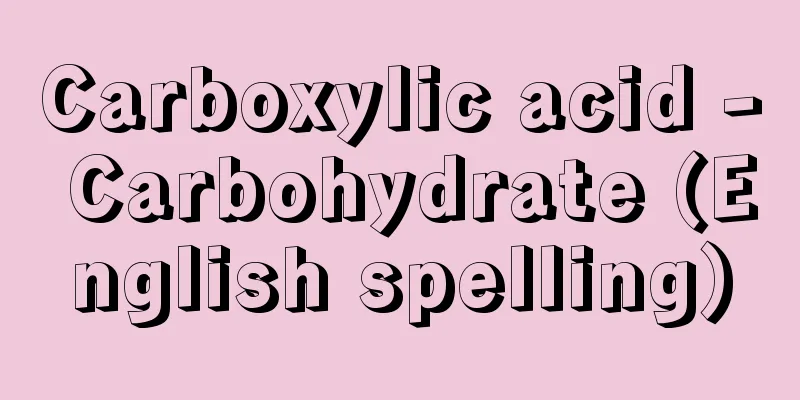Carboxylic acid - Carbohydrate (English spelling)

|
Organic compounds that have a carboxyl group (-COOH) are generally called carboxylic acids and have the general formula RCOOH or RCO 2 H. They are also called carboxylic acids. The hydrogen in the carboxyl group dissociates and becomes acidic, hence the name carboxylic acid. [Masahiro Hirota and Yuko Suezawa] ClassificationCarboxylic acids can be classified according to the number of carboxy groups they have; those with one carboxy group are called monocarboxylic acids, those with two carboxy groups are called dicarboxylic acids, and those with three carboxy groups are called tricarboxylic acids. Chain monocarboxylic acids are widely distributed as components of fats and oils, and are therefore specifically called fatty acids. In addition to the carboxy group, carboxylic acids that have an amino group are called amino acids, carboxylic acids that have a hydroxy group are called hydroxy acids (oxy acids), and carboxylic acids that have a ketone carbonyl group are called keto acids (ketone acids). [Masahiro Hirota and Yuko Suezawa] NomenclatureCommon names are often used for carboxylic acids. These names are often derived from the location or the raw material when first obtained from nature, rather than from the structure. For example, formic acid is called formic acid because it is an acid found in ants (Latin: formica), and acetic acid is found in vinegar (Latin: acetum) at 3-4%. The dicarboxylic acid obtained by dry distillation of amber (Latin: succinum) is called succinic acid, and the acid that is produced when milk goes sour is called lactic acid, from the Latin word lact. In the first IUPAC method, the carboxylic acid is named by first replacing the carboxyl group -COOH with a methyl group CH3 , then adding "acid" to the end of the hydrocarbon name. In other words, the name of the carboxylic acid is created by adding "acid" to the name of a hydrocarbon with the same number of carbon atoms as the carboxylic acid. The IUPAC name of valeric acid is CH3- CH2 - CH2 -CH2- CH3 , which is the C5 hydrocarbon " pentane " when -COOH in the chemical formula CH3 - CH2 - CH2 - CH2 - CO is replaced with -CH3- . Therefore, valeric acid is named "pentanoic acid" by adding "acid" to the end. In the case of the English name, the "e" at the end of the hydrocarbon name "pentane" is replaced with "oic acid" to give the name "pentanoic acid". This nomenclature is often used for naming open-chain aliphatic carboxylic acids, but is not commonly used for other carboxylic acids. Instead, a naming system in which the -COOH group is treated as a substituent named "carboxylic acid" and is added after the name of the skeleton is widely used. For example, cC 5 H 9 -COOH, in which one hydrogen of cyclopentane cC 5 H 10 is replaced with -COOH, is called "cyclopentane carboxylic acid," and C 6 H 5 -COOH, in which one hydrogen of benzene C 6 H 6 is replaced with -COOH, is called benzene carboxylic acid (also commonly known as benzoic acid). This naming system has the advantage that the compound "has a carboxy group and exhibits the properties of a carboxylic acid" is clearly indicated from the name, and is therefore widely used. Carboxylic acids can also be named by using the prefix "carboxy" instead of the suffix "carboxylic acid". This nomenclature is rarely used for carboxylic acids that only have a carboxy group, but is sometimes used when there are two or more substituents, such as in the case of [(2-carboxy)ethyl]trimethylammonium chloride [(CH 3 ) 3 NCH 2 CH 2 COOH] + Cl - .
Location and ImportanceCarboxylic acids are important components of fats and oils and are widely distributed throughout the animal and plant kingdoms. Many types of carboxylic acids are obtained from animals and plants, but most of them are saturated and unsaturated straight-chain carboxylic acids. Almost all animal and vegetable oils called oils and fats exist as esters of the trihydric alcohol glycerol (glycerin). Esters of carboxylic acids and glycerol are called glycerides. Most of the carboxylic acids that make up animal and vegetable oils have 16 and 18 carbon atoms, and vegetable oils that contain a lot of unsaturated carboxylic acids are liquid and nutritionally excellent as food. Acetic acid, which has a small number of carbon atoms, is contained in about 3% of vinegar as a component. Esters of carboxylic acids such as acetic acid and butyric acid and monohydric alcohols have an aromatic scent and are found in fruits, and synthetic products are used as flavorings for food. Furthermore, many dicarboxylic acids and tricarboxylic acids, such as malic acid and citric acid, play important roles in the metabolic pathway that converts nutrients into energy in the body. This pathway is called the tricarboxylic acid pathway (TCA pathway, Krebs pathway). As mentioned above, carboxylic acids are closely related to the vital activities of living organisms, and are often produced by microorganisms through fermentation. Fermentation to produce acetic acid by Acetobacter and fumaric acid by a type of Rhizopus is well known and is also used industrially. [Masahiro Hirota and Yuko Suezawa] Manufacturing methodBroadly speaking, there are three methods: (1) converting an existing carbon atom into a carboxyl group by oxidation of an alcohol or aldehyde, (2) introducing a new carboxyl group by carboxylation of an organometallic compound, and (3) replacing a halogen compound with a cyano group -C≡N followed by hydrolysis. [Masahiro Hirota and Yuko Suezawa] (1) Oxidation of alcohols, aldehydes, etc.Carboxylic acids can be obtained by oxidation of primary alcohols or aldehydes, for example, heptanal from castor oil is a source of n -heptanoic acid.
The haloform reaction is an oxidation reaction that can be used to synthesize carboxylic acids in the laboratory. When a compound with an acetyl group (RCOCH 3 ) is halogenated with molecular halogens (Cl 2 , Br 2 , I 2 ) in the presence of an alkali such as sodium hydroxide, trihaloacetyl compounds (RCOCX 3 : X = Cl, Br, I) are obtained as the main product, and when this is hydrolyzed with an alkali hydroxide, the alkali salt of the carboxylic acid RCOOM (M = Na, K) and the haloform CHX 3 are produced. This reaction makes use of the fact that the halogenation of the second hydrogen of the acetyl group is faster than that of the first hydrogen, and the halogenation of the third hydrogen proceeds even faster. When Cl 2 is used for halogenation, chloroform CHCl 3 is produced as the haloform, when Br 2 is used, bromoform CHBr 3 is produced, and when I 2 is used, iodoform CHI 3 is produced. Iodoform is a yellow solid with a characteristic odor, which makes this reaction convenient for detecting acetyl groups, but when the reaction is carried out for the purpose of synthesizing carboxylic acids, chlorine or bromine and an alkali are usually used. This reaction can be used not only for the detection of acetyl groups, but also for the detection of 1-hydroxyethyl groups, which can be oxidized to acetyl groups. [Masahiro Hirota and Yuko Suezawa] (2) Addition of Grignard reagents to carbon dioxideThe Grignard reagent is produced by reacting an alkyl halide with metallic magnesium in ether. The magnesium salt of a carboxylic acid is produced by adding this reagent to carbon dioxide. This method is excellent for producing a carboxylic acid with one more carbon from an alkyl halide, but since chlorine attached to an aromatic ring is difficult to turn into a Grignard reagent, bromide or iodide are used to produce aromatic carboxylic acids.
(3) Hydrolysis of nitrilesNitriles are compounds with a -C≡N triple bond (cyano group), also known as alkyl cyanides. When the -C≡N bond is hydrolyzed, it first reacts with one molecule of water to form an amide, and when it is completely hydrolyzed, it forms a carboxylic acid and ammonia.
[Masahiro Hirota and Yuko Suezawa] natureThe first characteristic of carboxylic acids is their acidity, which occurs when the hydrogen in the carboxyl group dissociates in an aqueous solution to produce a hydronium ion (hydrogen ion).
Carboxylic acids are acidic because the OH bond of the carboxyl group breaks easily to produce -COO- and H + . There are two main reasons why the OH bond of the carboxyl group dissociates more easily than other hydroxyl groups. One is that the hydroxyl group is bonded to a carbonyl group, which has a strong tendency to attract electrons. The carbonyl group attracts the electrons on the oxygen of the hydroxyl group, which reduces the electron density on that oxygen and attracts the electrons of the hydrogen atom. Therefore, the electrons that make up the OH bond are attracted to the oxygen, which reduces the number of electrons around the hydrogen atom, making it easier to separate as H + . This effect is called the inductive effect. Another reason is that the carboxylate anion formed by dissociation is stabilized by resonance. Carboxylic acid dissociation is more likely to occur when the negative charge in the resulting ion is distributed over many atoms, making it more stable. In carboxylic acids, the bonds connecting the carbon of the carboxyl group and the two oxygen atoms (CO and C=O) are of different lengths and asymmetric. In contrast, in the case of the carboxylate ion, the bonds become equal in length due to resonance, and the negative charge is evenly distributed over the two oxygen atoms, stabilizing the bond. [Masahiro Hirota and Yuko Suezawa] Acid strengthThe p K a values of carboxylic acids are as shown in . The smaller the p K a value, the easier it is for the acid to dissociate and the stronger the acid is. The p K a of the series of linear saturated carboxylic acids from acetic acid to nonanoic acid is 4.6 to 5, and branching of the alkyl chain does not have much effect. The first, formic acid, is an exception, and is significantly more acidic than carboxylic acids with alkyl groups attached to the carboxy group. Looking at the p K a values of the acids in the second and third groups in the table, we can see that the acidity increases when they are replaced by halogens, hydroxyl groups, and other groups. The reason for the increase in acidity can also be explained by the inductive effect concept mentioned above. When one α (alpha) hydrogen atom in acetic acid is replaced by chlorine, the acidity increases significantly, and the p K a of chloroacetic acid, CH 2 ClCOOH, is 2.81. Chlorine has a strong ability to attract electrons, making it easier for hydrogen to dissociate. Bromine is weaker at attracting electrons than chlorine, and iodine is even weaker than bromine. The order of acidity of the substituted acetic acids in coincides with the order of electronegativity, a measure of the ability to attract electrons. Comparing the pK a of α-chloropropionic acid and β (beta)-chloropropionic acid, we see that the inductive effect of the Cl substituent decreases rapidly as it moves away from the carboxy group. α-Chloropropionic acid is much more acidic than propionic acid itself, while β-chloropropionic acid is only slightly more acidic than propionic acid. As the hydrogen atoms in the methyl group of acetic acid are successively replaced by one, two, and three chlorines, the acidity of the acid increases, and the acidity of trichloroacetic acid is almost as strong as that of inorganic acids. In addition, hydroxyl and nitro groups also have the effect of strengthening the acidity, but alkyl groups have the opposite effect of weakening the acidity. The fact that acetic acid is a weaker acid than formic acid indicates that the methyl group has a smaller ability to attract electrons than the hydrogen atom, that is, relatively speaking, it has the ability to push out electrons, as shown by the arrow CH 3 →COOH. The p K a of the higher homologues of acetic acid is very close to that of acetic acid, which indicates that the difference in the electron-pushing power of methyl, ethyl, and higher alkyl groups is very small. Summarizing the above results, the acidity changes according to the type of substituent in the following order: Carboxylic acids exist alone as monomer molecules shown in (1) in only in dilute solutions of polar solvents such as water. Carboxylic acids exist mostly as dimers (as shown in (2)), in which two molecules are bound together, not only in liquid state but also in gaseous and very dilute solutions. The bond shown by the dashed line in this formula is a hydrogen bond, a weak bond formed between the hydrogen atom of the hydroxyl group bound to the oxygen atom and the oxygen of the carbonyl group of another carboxylic acid molecule. In liquids and solids, many more carboxylic acid molecules may be linked in a chain by hydrogen bonds to form a polymer. Because the two molecules are strongly associated, even when carboxylic acids are boiled to gasify, the dimer (2) remains intact. Therefore, their boiling and melting points are higher than those of other types of compounds with similar molecular weights and shapes. When carboxylic acids are converted to methyl or ethyl esters, the boiling and melting points usually decrease, even though the molecular weight increases. This is because esters do not have hydroxy groups and cannot form hydrogen bonds. [Masahiro Hirota and Yuko Suezawa] reactionThe reactivity of carboxylic acids can be divided into reactions as an acid, reactions of the hydroxyl group -OH, and reactions of the carbonyl group =O. (1) Reaction as an acid Carboxylic acids are acidic and can combine with bases to form salts, which is different from alcohols, aldehydes, ketones, ethers, esters, etc. They react quantitatively with strong bases such as sodium hydroxide and potassium hydroxide to form salts. This reaction is used to determine the amount of acid by neutralization titration. RCOOH + NaOH (2) Halogenation There are several known reactions in which the hydroxy group of a carboxylic acid is replaced by another group. In these reactions, the carboxylic acid reacts by breaking the CO bond connecting the acyl group RCO- to the hydroxy group. A well-known reaction of this type is the halogenation reaction to produce an acid halide. Carboxylic acids are halogenated using chlorinating agents such as phosphorus pentachloride, phosphorus trichloride, phosphoryl chloride, or thionyl chloride to produce acid chlorides, phosphorus tribromide or thionyl bromide to produce acid bromides, and phosphorus triiodide to produce acid iodides. Using the reagents listed here, it is possible to halogenate only the hydroxy group of the carboxylic acid without halogenating the alkyl group of the carboxylic acid.
(3) Esterification The most important reaction in which the CO bond of the carboxy group of a carboxylic acid is broken is the esterification reaction. When a carboxylic acid is mixed with an excess amount of alcohol (a larger number of moles than the carboxylic acid) and a catalytic amount of concentrated sulfuric acid (about 3% of the total reaction solution) and heated, an ester is produced. This esterification method is effective for a wide range of combinations of primary and secondary alcohols and carboxylic acids. However, the esterification of tertiary alcohols such as tert -butyl alcohol proceeds via a different pathway in which the CO bond of the alcohol is cleaved. (4) Kolbe's electrolysis reaction When a direct current is passed through a solution of carboxylate, the carboxylate ions move toward the anode and the metal ions move toward the cathode, causing electrolysis. As an example, let's take the Kolbe reaction of potassium acetate CH 3 COOK. In an aqueous solution, potassium acetate dissociates into acetate ions CH 3 COO - and potassium ions K +. When electrolysis is performed, the acetate ions move toward the anode and the potassium ions move toward the cathode, imparting an electric charge to the electrode and losing their own electric charge. The potassium (metal) that has lost its electric charge on the cathode immediately reacts with water to become potassium hydroxide, returning to K + .
(5) Decarboxylation reaction When a carboxylic acid is heated to a high temperature, the carboxyl group is eliminated as carbon dioxide and the resulting hydrocarbon is formed. This reaction proceeds easily by simply heating to 100-150°C in the case of malonic acid, which has two carboxyl groups on one carbon atom, and in the case of carboxylic acids that have electron-attracting substituents such as nitro, cyano, and carbonyl on the carbon to which the carboxyl group is attached. In the case of adipic acid, decarboxylation and cyclization occur to form a cyclic ketone. Decarboxylation is easier to manipulate using carboxylates than the carboxylic acid itself; for example, heating sodium acetate with sodium hydroxide produces methane and sodium carbonate at the same time.
[Masahiro Hirota and Yuko Suezawa] "Aliphatic Monocarboxylic Acids" and "Aliphatic Di- and Polycarboxylic Acids" edited by Otake Mujio ("Organic Chemistry 4: Aliphatic Compounds 3" pp.141-415, 1959, Asakura Shoten) ▽ "Oxyacids" and "Oxoacids" edited by Otake Mujio ("Organic Chemistry 5: Aliphatic Compounds 4" pp.1-161, pp.163-261, 1959, Asakura Shoten) ▽ "Basic Chemistry Selection 4: Chemistry of Functional Groups" by Shiota Michio (1982, Shokabo) ▽ "Basic Organic Chemistry" by Oshima Koichiro (2000, Tokyo Kagaku Dojin) ▽ "Saul Patai: The Chemistry of Carboxylic Acids and Esters" (1969, Interscience Publishers, London and New York) [References] | | |©Shogakukan "> Classification of Carboxylic Acids ©Shogakukan "> Properties of Carboxylic Acids [Table] ©Shogakukan "> Acid strength of carboxylic acids (Figure A) ©Shogakukan "> Carboxylic acid monomers and dimers (Figure B) Source: Shogakukan Encyclopedia Nipponica About Encyclopedia Nipponica Information | Legend |
|
カルボキシ基(カルボキシル基)-COOHをもつ有機化合物を、一般にカルボン酸といい、一般式RCOOHあるいはRCO2Hで表す。カルボキシル酸ということもある。カルボキシ基の水素は解離して酸性を示すので、カルボン酸の名が与えられている。 [廣田 穰・末沢裕子] 分類カルボン酸はカルボキシ基の数により分類することができ、カルボキシ基を1個もつものをモノカルボン酸、2個もつものをジカルボン酸、3個もつものをトリカルボン酸という。 鎖状のモノカルボン酸は、脂肪や油脂の成分として広く分布しているので、とくに脂肪酸といわれる。またカルボキシ基のほかに、アミノ基をもつカルボン酸をアミノ酸、ヒドロキシ基をもつカルボン酸をヒドロキシ酸(オキシ酸)、ケトンのカルボニル基をもつカルボン酸をケト酸(ケトン酸)という。 [廣田 穰・末沢裕子] 命名法カルボン酸の名称としては慣用名がよく用いられている。そして、それらは構造に由来する名称ではなく、所在や天然から最初に得られた際の原料などに由来する名称であることが多い。たとえば、ギ酸の場合は、英語名がformic acidであるが、これはアリ(ラテン語formica)に含まれている酸であることに基づいて命名され、酢酸acetic acidは酢(す)(ラテン語acetum)の中に3~4%含まれている。また、こはく(ラテン語succinum)を乾留すると得られるジカルボン酸はコハク酸succinic acidと名づけられ、牛乳が腐って酸っぱくなったときにできる酸はラテン語の乳lactから乳酸lactic acidの名でよばれる。 第一のIUPAC命名法では、まず、名前をつけたいカルボン酸がもっているカルボキシ基-COOHをメチル基CH3に置きかえた炭化水素名をつくり、続いてこの炭化水素名の語尾に「酸」をつけると、カルボン酸の名前ができあがる。いいかえるとカルボン酸と同じ数の炭素をもつ炭化水素名に「酸」をつけると「カルボン酸」の名前になる。吉草酸のIUPAC名は、吉草酸の化学式CH3-CH2-CH2-CH2-COの-COOHを-CH3-に置きかえるとCH3-CH22-CH2-CH2-CH3になり、これはC5炭化水素の「ペンタン」である。したがって吉草酸はその語尾に「酸」をつけて、「ペンタン酸」になる。英語名の場合は炭化水素名「pentane」の語尾の「e」を「oic acid」にかえて「pentanoic acid」と命名する。この命名法は鎖式の脂肪族カルボン酸の命名にはしばしば使われるが、その他のカルボン酸の命名には、あまり使われない。 これにかわって、-COOH基を「カルボン酸」という名前の置換基として取り扱い、骨格の名前の後につける命名法が広く使われている。たとえば、シクロペンタンc-C5H10の水素1個を-COOHで置き換えたc-C5H9-COOHは「シクロペンタンカルボン酸」とよばれ、ベンゼンC6H6の水素1個を-COOHで置き換えたC6H5-COOHはベンゼンカルボン酸(安息香酸という慣用名もある)とよばれる。この命名法を用いると化合物が「カルボキシ基をもっていてカルボン酸の性質を示す」ことが名前からはっきりわかる利点があるので、よく使われる。 「カルボン酸」(接尾語)のかわりに「カルボキシ」(接頭語)を骨格名の前につけて、カルボン酸を表す命名法もある。この命名法はカルボキシ基だけをもつカルボン酸に使われることは少ないが、塩化[(2-カルボキシ)エチル]トリメチルアンモニウム[(CH3)3NCH2CH2COOH]+Cl-の例のように、2種類以上の置換基がある場合には、ときとして使われる。
所在と重要性カルボン酸は、脂肪ないしは油脂の重要な構成成分として、広く動植物界に分布している。動植物から得られるカルボン酸の種類は多いが、その大部分は飽和および不飽和の直鎖カルボン酸である。油脂・脂肪などとよばれている動植物油はほとんどすべてが、3価アルコールのグリセロール(グリセリン)のエステルとして存在する。カルボン酸とグリセロールとのエステルはグリセリドとよばれている。動植物油を構成しているカルボン酸は、炭素数16および18のものが多く、不飽和カルボン酸を多く含む植物油は液体で、食品として栄養的に優れている。炭素数が少ない酢酸は、食酢の成分として3%ほど含まれている。酢酸、酪酸などのカルボン酸と一価アルコールとのエステルは芳香があり果実中に存在し、合成物は食品の着香料・フレーバーとしての用途がある。 また、リンゴ酸、クエン酸など多くのジカルボン酸・トリカルボン酸は、生体内において栄養物質をエネルギーに変える代謝回路において重要な役割を果たしている。この回路はトリカルボン酸回路(TCA回路、クレブスKrebs回路)と名づけられている。前述のように、カルボン酸は生物の生活活動と密接な関係があり、微生物が発酵によりつくりだす場合も多い。アセトバクターによる酢酸、クモノスカビの一種によるフマル酸を生成する発酵は有名で、工業的にも利用されている。 [廣田 穰・末沢裕子] 製法大別すると、(1)アルコール、アルデヒドなどの酸化により、すでにある炭素原子をカルボキシ基に変える方法と、(2)有機金属化合物のカルボキシル化などにより新たにカルボキシ基を導入する方法と、(3)ハロゲン化合物をシアノ基-C≡Nにより置換しそれに続いて加水分解する方法がある。 [廣田 穰・末沢裕子] (1)アルコール、アルデヒドなどの酸化第一アルコールまたはアルデヒドの酸化によってカルボン酸を得ることができる。たとえば、ひまし油からとれるヘプタナールはn-ヘプタン酸の原料となる。
実験室でカルボン酸を合成するのに利用できる酸化反応としてハロホルム反応がある。アセチル基をもつ化合物(RCOCH3)を水酸化ナトリウムなどのアルカリの存在下で分子状ハロゲン(Cl2,Br2,I2)によりハロゲン化すると、トリハロアセチル化合物(RCOCX3:X=Cl,Br,I)が主生成物として得られ、これを水酸化アルカリにより加水分解すると、カルボン酸のアルカリ塩RCOOM(M=Na、K)とハロホルムCHX3が生成する。この反応ではアセチル基の一つ目の水素のハロゲン化に比べて二つ目の水素のハロゲン化のほうが速く、三つ目のハロゲン化がさらに速く進むということを利用している。ハロゲン化にCl2を用いた場合にはハロホルムとしてクロロホルムCHCl3、Br2の場合にはブロモホルムCHBr3、I2の場合にはヨードホルムCHI3が生成する。 ヨードホルムは黄色の固体で特有のにおいをもっているので、この反応をアセチル基の検出に使う場合には便利であるが、カルボン酸合成の目的でこの反応を行う場合は、塩素または臭素とアルカリを用いるのが普通である。この反応はアセチル基だけでなく、酸化するとアセチル基になる1-ヒドロキシエチル基 [廣田 穰・末沢裕子] (2)グリニャール試薬の二酸化炭素への付加ハロゲン化アルキルと金属状のマグネシウムとをエーテル中で反応させるとグリニャール試薬ができる。この試薬を二酸化炭素に付加させるとカルボン酸のマグネシウム塩ができる。この方法は、ハロゲン化アルキルから炭素が一つ多いカルボン酸をつくる方法として優れているが、芳香環についた塩素はグリニャール試薬になりにくいので、芳香族のカルボン酸をつくるには臭化物かヨウ化物を用いる。
(3)ニトリルの加水分解ニトリルは-C≡N三重結合(シアノ基)をもつ化合物であり、シアン化アルキルともよばれている。その-C≡N結合を加水分解すると、まず1分子の水が反応してアミドになり、さらに完全に加水分解するとカルボン酸とアンモニアになる。
[廣田 穰・末沢裕子] 性質カルボン酸の特徴として第一にあげなければならないのは、その酸性である。酸性は、カルボキシ基の水素が水溶液中で次の解離をおこしてヒドロニウムイオン(水素イオン)を生ずることによる。
カルボン酸が酸性を示すのは、カルボキシ基のO-H結合が切れて-COO-とH+を生成しやすいからである。他のヒドロキシ基に比べてカルボキシ基のO-H結合だけが解離しやすいおもな理由は二つある。その一つは、電子を引き寄せる性質が大きいカルボニル基にヒドロキシ基が結合していることである。カルボニル基がヒドロキシ基の酸素上の電子を引き寄せるので、その酸素上の電子密度が低くなって水素原子の電子を引き付ける。したがってO-H結合をつくっている電子は、酸素のほうに引き付けられて水素原子の周りの電子は少なくなり、H+として離れやすくなる。このような効果を誘起効果とよんでいる。 もう一つの理由は、解離してできたカルボン酸陰イオンが共鳴により安定していることによる。カルボン酸の解離は、できるイオンにおいて負の電荷が多くの原子上に分散していて安定化しているほどおこりやすい。カルボン酸ではカルボキシ基の炭素と二つの酸素原子とを結ぶ結合(C-OとC=O)は、長さが違い、非対称である。これと対照的にカルボン酸イオンになると、共鳴により両者は等しい長さになり、負電荷は二つの酸素原子上に均等に分布して安定化する。 [廣田 穰・末沢裕子] 酸の強さカルボン酸のpKa値はのとおりである。pKa値が小さいほど酸としての解離がおこりやすく、強い酸である。酢酸からノナン酸に至る直鎖状飽和のカルボン酸の系列のpKaは4.6~5であり、アルキル基の鎖が枝分れしてもあまり影響はない。最初のギ酸は例外で、カルボキシ基にアルキル基のついたカルボン酸に比べてかなり酸性が強い。表中第2および第3群の酸のpKaをみると、ハロゲン、ヒドロキシ基その他の基で置換されると酸性が強くなることがわかる。酸性が強くなる理由も、先に述べた誘起効果の考え方で説明できる。酢酸のα(アルファ)-水素1個を塩素と置換すると酸性は著しく増加し、クロロ酢酸CH2ClCOOHではpKaは2.81である。塩素は強く電子を引き付ける力があるので、水素が解離しやすくなる。電子を引き付ける力は臭素では塩素より弱く、ヨウ素ではさらに臭素より弱い。の置換酢酸の酸性の強さの順序は、電子を引き寄せる力の指標である電気陰性度の順序と一致する。α-クロロプロピオン酸およびβ(ベータ)-クロロプロピオン酸のpKaを比較すると、置換基Clがカルボキシ基から遠ざかるにつれて、その誘起効果が急速に減少することがわかる。α-クロロプロピオン酸は、プロピオン酸自体よりはるかに強酸性であるが、β-クロロプロピオン酸はプロピオン酸よりわずかに強いにすぎない。 酢酸のメチル基の水素を順次1個、2個、3個の塩素により置換していくとその酸性はしだいに増加し、トリクロロ酢酸の酸性は、無機酸とほとんど変わらないぐらい強くなっている。このほかにヒドロキシ基、ニトロ基なども酸性を強める作用をもっているが、アルキル基は逆に酸を弱める効果を示す。酢酸がギ酸よりも弱酸であることはメチル基が水素原子よりも電子を引き寄せる力が小さいこと、すなわち相対的にいえば、CH3→COOHの矢印で示されるように電子を押し出す力があることを示している。酢酸の高位同族体のpKaはきわめて酢酸に近い値をとるが、このことはメチル、エチルおよびそれより高位なアルキル基の電子を押し出す力の差が非常に小さいことを示している。以上の結果をまとめると置換基の種類により酸性が次の順序で変化することがわかる。 カルボン酸が()の(1)で示される単量体の分子として単独で存在するのは、水などの極性溶媒薄い溶液中だけである。カルボン酸は液体の状態ではもちろんのこと、気体またはかなり薄い溶液にしても、大部分は(2)のような2分子が結び付いた会合体(二量体)として存在する。この式で破線で示した結合は水素結合であり、酸素原子と結合しているヒドロキシ基の水素原子ともう一つカルボン酸分子のカルボニル基の酸素の間に生ずる弱い結合である。液体や固体の場合には、もっと多くのカルボン酸分子が水素結合により鎖状につながって多量体になっていることがある。 2分子が強く会合しているので、カルボン酸を沸騰させて気体にする場合でも、(2)の二量体は壊れないで残る。したがって、同程度の分子量で同じような形をしている他の種類の化合物に比べると沸点も融点も高くなっている。カルボン酸をメチルエステルやエチルエステルに変えると、分子量は大きくなるにもかかわらず、沸点も融点も下がるのが普通である。その理由はエステルにはヒドロキシ基がないので水素結合ができないからである。 [廣田 穰・末沢裕子] 反応カルボン酸の反応性は酸としての反応、ヒドロキシ基-OHの反応、カルボニル基=Oの反応に分けて考えられる。 (1)酸としての反応 カルボン酸は酸性を示し、塩基と結合して塩を形成しうる点でアルコール、アルデヒド、ケトン、エーテル、エステルなどと異なる。水酸化ナトリウム、水酸化カリウムなどの強塩基とは定量的に反応して塩になる。この反応は中和滴定により酸の量を決定するのに応用されている。 RCOOH+NaOH (2)ハロゲン化 カルボン酸のヒドロキシ基を他の基に置き換える反応もいくつか知られている。これらの反応では、カルボン酸はアシル基RCO-とヒドロキシ基を結ぶC-O結合が切れて反応する。この型の反応としてよく知られているのは、ハロゲン化により酸ハロゲン化物ができる反応である。酸塩化物をつくるには五塩化リン、三塩化リン、塩化ホスホリル、塩化チオニルなどの塩素化剤を用い、酸臭化物をつくるには三臭化リンまたは臭化チオニルを用い、酸ヨウ化物をつくるには三ヨウ化リンを用いてカルボン酸をハロゲン化する。ここにあげた試薬を用いると、カルボン酸のアルキル基をハロゲン化せずに酸のヒドロキシ基だけをハロゲン化できる。
(3)エステル化 カルボン酸のカルボキシ基のC-O結合が切れる反応としてもっとも重要なのは、エステル化の反応である。カルボン酸を過剰量のアルコール(カルボン酸と比べて多いモル数)と触媒量の濃硫酸(反応液全体のおよそ3%ぐらいの量)とを混ぜて加熱するとエステルを生成する。この方法によるエステル化は広い範囲の第一アルコールおよび第二アルコールとカルボン酸の組合せに有効である。 しかし、tert-ブチルアルコールなどの第三アルコールのエステル化は、アルコールのC-O結合が切れる別の経路で反応が進む。 (4)コルベの電解反応 カルボン酸塩の溶液に直流の電流を通すと、カルボン酸イオンは陽極に、金属イオンは陰極に向かって移動して電気分解をおこす。1例として、酢酸カリウムCH3COOKのコルベ反応を取り上げると、酢酸カリウムは水溶液中では酢酸イオンCH3COO-とカリウムイオンK+とに解離しているので、電気分解を行うと、酢酸イオンは陽極に向かい、カリウムイオンは陰極に向かって移動し電極に電荷を与えて自らは電荷を失う。陰極上で電荷を失ったカリウム(金属)はただちに水と反応して水酸化カリウムになり、K+に戻る。
(5)脱炭酸反応 カルボン酸を高温に加熱するとカルボキシ基が二酸化炭素として脱離して炭化水素になる。この反応は一つの炭素原子上に二つのカルボキシ基をもつマロン酸、カルボキシ基のついている炭素上にニトロ、シアノ、カルボニルなどの電子を引き寄せる性質の置換基をもつカルボン酸では100~150℃に加熱するだけで容易に進行する。 アジピン酸では、脱炭酸反応とともに環化がおこり、環状ケトンになる。脱炭酸反応はカルボン酸自体よりも、カルボン酸塩を用いるほうが実験操作が容易で、たとえば酢酸ナトリウムを水酸化ナトリウムとともに加熱するとメタンが発生し、同時に炭酸ナトリウムができる。
[廣田 穰・末沢裕子] 『小竹無二雄監修「脂肪族モノカルボン酸」「脂肪族ジおよびポリカルボン酸」(『大有機化学4 脂肪族化合物3』pp.141~415. 1959・朝倉書店)』▽『小竹無二雄監修「オキシ酸」「オキソ酸」(『大有機化学5 脂肪族化合物4』pp.1~161, pp.163~261. 1959・朝倉書店)』▽『塩田三千夫著『基礎化学選書4 官能基の化学』(1982・裳華房)』▽『大嶌幸一郎著『基礎有機化学』(2000・東京化学同人)』▽『Saul PataiThe chemistry of carboxylic acids and esters(1969, Interscience Publishers, London and New York)』 [参照項目] | | |©Shogakukan"> カルボン酸の分類 ©Shogakukan"> カルボン酸の性質〔表〕 ©Shogakukan"> カルボン酸の酸の強さ〔図A〕 ©Shogakukan"> カルボン酸の単量体と二量体〔図B〕 出典 小学館 日本大百科全書(ニッポニカ)日本大百科全書(ニッポニカ)について 情報 | 凡例 |
Recommend
Piast dynasty - Piastów
A princely family of Polani, based in Gniezno, who...
Kingdom of Kush - Kush Kingdom (English spelling)
The Black Kingdom flourished in the upper reaches ...
Music
…However, the concept of music in the West has un...
Naval Commander - Chinjufushogun
The military governor of Chinjufu, the military g...
Kronos - Kuronosu (English spelling) Kronos
A god in Greek mythology. In Roman mythology, he ...
Armstrong, HE - Armstrong
…So, since the mid-19th century, the teaching met...
Kaiyu (sea cow) - Kaiyu (English spelling) sea cow
A general term for mammals belonging to the order ...
Mount Omoto
A mountain in the northern part of Ishigaki Islan...
Chennai
...Population: 3.841 million (1991), metropolitan...
American dry wood termite - American dry wood termite
...The Formosan termite is found south of Amami a...
Religious art
It refers to art created for religious purposes, ...
Eugene Pleasants Odum
1913‐2002 American ecologist. Born in New Hampshir...
Hasheesh (English spelling) ḥashish [Arabic]
This refers to cannabis, also known as hashish. It...
Albérès, René-Marill
Born: May 10, 1921 in Perpignan [Died] May 8, 1982...
Oshima clan
…The various Ama clans, led by their chiefs (Ama ...









